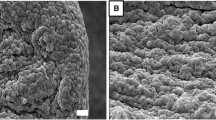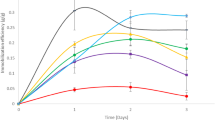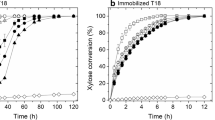Abstract
Five, highly flocculeng strains of Saccharomyces cerevisiae, isolated from wine, were immobilized in calcium alginate beads to optimize primary must fermentation. Three cell-recycle batch fermentations (CRBF) of grape musts were performed with the biocatalyst and the results compared with those obtained with free cells. During the CRBF process, the entrapped strains showed some variability in the formation of secondary products of fermentation, particularly acetic acid and acetaldehyde. Recycling beads of immobilized flocculent cells is a good approach in the development and application of the CRBF system in the wine industry.
Similar content being viewed by others
References
Cantarelli, C. 1989 The use of immobilized yeasts in wine fermentation. Italian Journal of Food Science 1, 3–20.
Ciani, M. & Rosini, G. 1991 Sparkling-wine production by cell-recycle fermentation process (CRBF). Biotechnological Letters 13, 533–536.
Deviès, C., Cachon, R., Cavin, J.F. & Prévost, H. 1994 Immobilized cell technology in wine production. Critical Reviews in Biotechnology 14, 135–155.
Fumi, M.D., Raggi, E., Battistotti, G. & Colagrande, O. 1994 Alginate immobilized Saccharomyces cerevisiae cell alterations during alcoholic fermentation. Italian Journal of Food Science 6, 325–338.
Fumi, M.D., Trioli, G., Colombi, M.G. & Colagrande, O. 1988 Immobilization of Saccharomyces cerevisiae in calcium alginate gel and its application to bottle-fermented sparkling wine production. American Journal of Enology and Viticulture 39, 267–272.
Norton, S. & D'Amore, T. 1994 Physiological effects of yeast cell immobilization: applications for brewing. Enzyme and Microbial Technology 16, 365–375.
Romano, P., Suzzi, G., Turbanti, L. & Polsinelli, M. 1994 Acetaldehyde production in Saccharomyces cerevisiae wine yeasts. FEMS Microbiology Letters 118, 213–218.
Rosini, G. 1986 Wine-making by cell-recycle-batch fermentation process. Applied Microbiology and Biotechnology 24, 140–143.
Rosini, G. & Ciani, M. 1993 Influence of sugar type and level on malate metabolism of immobilized Schizosaccharomyces pombe cells. American Journal of Enology and Viticulture 44, 113–117.
Ryder, D.S. & Masschelein, C.A. 1991 Immobilized yeast in brewing—a current perspective. In Proceedings of 23rd European Brewery Convention, Lisbon, pp. 345–352. New York: Oxford University Press.
Suzzi, G. & Romano, P. 1991 Flocculent phenotypes in wine yeasts. Letters in Applied Microbiology 13, 7–10.
Suzzi, G., Romano, P. & Zambonelli, C. 1984 Flocculation of wine yeasts: frequency, differences, and stability of the character. Canadian Journal of Microbiology 30, 36–39.
Author information
Authors and Affiliations
Rights and permissions
About this article
Cite this article
Suzzi, G., Romano, P., Vannini, L. et al. Cell-recycle batch fermentation using immobilized cells of flocculent Saccharomyces cerevisiae wine strains. World J Microbiol Biotechnol 12, 25–27 (1996). https://doi.org/10.1007/BF00327794
Received:
Accepted:
Issue Date:
DOI: https://doi.org/10.1007/BF00327794




